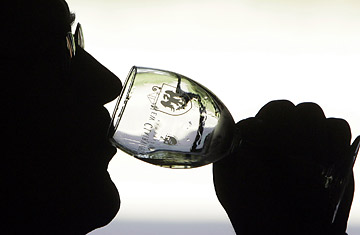
Technology applied to wine tasting means an important advance for quality control
Admittedly, it can't wax poetic about the mouthfeel of a pinot or the flavors of mown grass and flint in a 2007 sauvignon. But an electronic "tongue" recently unveiled by scientists at Barcelona's Institute for Microelectronics is capable of identifying different wines and may be used as a new weapon in the battle against wine fraud. In a study published last week in the Royal Society of Chemistry's journal the Analyst, Cecilia Jonquera-Jiménez and her colleagues announced that by using microsensors cued to chemical ions, their device, or "e-tongue," can distinguish among grapes and vintages.
The technology has been in the works for some time. Scientists at the Institute had already developed membranes that could distinguish mineral content in different waters. "It was Cecilia's idea to apply the technology to wine," says César Fernández, speaking for his colleague Jonquera-Jiménez. "When she spoke with people in the industry, they would tell her they needed a quick way to determine the components of a wine without having to send it off to a lab."
Using first grape juice and then wine as their test samples, Jonquera-Jiménez and her team attached a series of synthetic membranes to a silicon chip called a microsensor. Each membrane detects a different chemical component of the liquid — components that, when combined, mark the distinct characteristics of each grape varietal. So far, the device can distinguish among four: chardonnay, Aisén, malvasia and macabeu. It can also measure the difference between a 2005 vintage and a 2007. "It should even be able to identify, say, a chardonnay regardless of whether it was grown in France or California," says Fernández.
What's the value of an electronic tongue? Wine buyers, stung by recent reports of widespread fraud, will appreciate having an objective tongue on hand to weed out bogus bottles. "You could use it to verify that a wine was made from the proper grapes," says Mary O'Connor, wine director of Planeta Vino, a Madrid wine school. "For example, there are only five authorized grapes for a Rioja, but lots of winemakers sneak in cabernet anyway. This could help enforce the standards." The device, which is small, portable and relatively inexpensive, could also come in handy during the big business that is wine auctions. "Fraud is a big problem for auction houses," says O'Connor. "This is a way for them to verify a vintage."
For Antonio Palacios, professor of oenology at the University of Rioja, the significance is clear. "It represents an important advance for quality control," he says. "Wine is one of the most complex chemical substances out there, and no human palate can quantify its makeup objectively. This kind of electronic device can."
Jonquera-Jiménez plans to train the e-tongue to identify more varietals, and that, says, O'Connor, will only increase its value for wine educators like herself. "The human palate is unable to detect that a wine is, say, 20% merlot. A device [with a full range] would be an awesome tool for explaining the mystery of what goes into a wine." Still, she says, don't look for the e-tongue to completely replace the human palate. "This kind of device is purely technical. It's the human palate that determines whether a wine is worth drinking."
Indeed, the world's most famous wine expert doesn't expect the e-tongue to put him out of business anytime soon. Although he admits that his knowledge of the device is limited, critic Robert Parker of Wine Advocate says, "It's hard to believe any computer can interpret the nuances of smell and taste as well as a human's olfactory gland."
